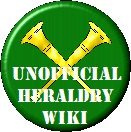Chevron
WARNING: Do not cite this page as a reference. This page is on this wiki to make the content "searchable" and easier to find. If you find the information you seek here, go to the original sources to verify the information and use them for your documentation.
Examples:[edit | edit source]
Period:[edit | edit source]
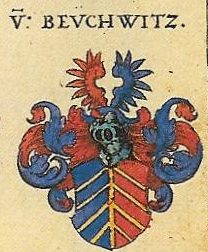
|
| Siebmacher 1605, skinny chevrons on a skinny pale (vergette), image courtesy of Rayne Evynwod. |
| Armorial |
| Armorial et Traité d'Héraldique, 1475, f169 - per chevron throughout, piles inverted throughout x 2? |
Modern:[edit | edit source]
Pictorial Dictionary, 3rd edition:[edit | edit source]
Per Mistholme, may use PicDic art for submission purposes without prior permission.
Vector Graphics:[edit | edit source]
Annotated Pennsic Traceable Art Project:[edit | edit source]
Precedents:[edit | edit source]
Precedents of the SCA College of Arms - http://heraldry.sca.org/laurel/precedents.html
Morsulus Heralds Website - http://www.morsulus.org/ (to search the LoARs and Precedents)
Use the above links to be sure any precedents listed below haven't been superseded by newer precedents.
Definition:[edit | edit source]
May 2011 - proper depictions:[edit | edit source]
From Wreath: Chevrons, Per Chevron, and Their Inversions [May 2011 Cover Letter] On the Cover Letter for the December 2010 LoAR, published in February 2011, we asked commenters for their opinions on a proposal regarding more proper depictions of chevrons, the per chevron line of division, and their inversions. We proposed putting strong limitations on charges above the tip of a chevron or a per chevron line of division, or below the tip of a chevron inverted or a per chevron inverted line of division. Many examples were presented of charges above a chevron or per chevron line of division, or below the point of a chevron inverted or per chevron inverted line of division in period heraldry, so we will not be limiting that practice. Examples provided in commentary did present evidence that in period, chevrons and the per chevron line of division were typically drawn to take up as much space as possible; this generally meant that the line was fairly steep, throughout, or nearly so. However, in some heraldic jurisdictions, the chevron was much shallower. Therefore, we will not regulate the steepness of chevrons or the per chevron or per chevron inverted lines of division at this time. What was found, however, was that in every case, the chevron or per chevron line was vertically centered in the area available to it, taking the placement of any secondaries present into account. The notional mid-line of the charge or line of division would nearly always line up with a per fess line drawn centered on the available space. Pictures help: Notice that on the escutcheon attached as figure 1, the dashed line X is the per fess line of the entire escutcheon. However, in the presence of the chief, the available space has a notional mid-point line marked by the dashed line labeled Y. Similarly, both chevrons (figures 2 and 3) have a notional mid-point line at c, and the distance above the mid-line (a) and below it (b) should be the same.
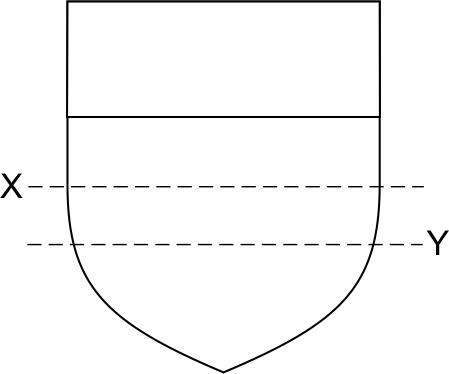 Figure 1 (Escutcheon) Figure 1 (Escutcheon)
|
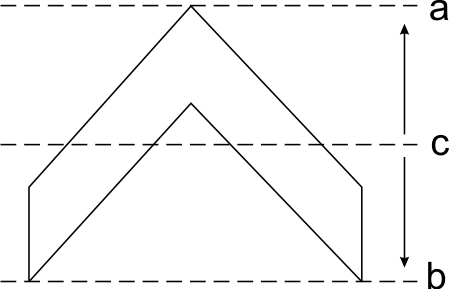 Figure 2 (Steep) Figure 2 (Steep)
|
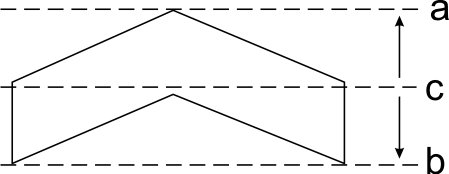 Figure 3 (Shallow) Figure 3 (Shallow)
|
The following guidelines on chevrons and per chevron field divisions, and their inversions, will be enforced starting at the November 2011 Laurel meetings:
- Per chevron lines of division, chevrons as a primary charge, and their inversions should have their mid-line placed roughly on the notional mid-line of the space available to them.
- If substantially more of the charge or line appears to be on one side of the field's notional mid-line as compared to the amount on the other side, the submission will be returned for a redraw or re-design.
- Chevrons etc. move based on the position of secondaries: allowances will be made for times when the charges around or above and below interfere with the placement. A chevron etc. between three charges should be in the same place on the field as a chevron with no charges on the field, but a chevron below a single charge fesswise, or a chevron below a group of charges in fess, may be further down the field. A chevron etc. placed above a single charge or group of charges in base may be further up on the field.
The end result is that per chevron lines of division alone on the field, or between three charges, should not be entirely, or even mostly, below where a per fess line would be. Chevrons which are shallow enough to be confused with a fess remain unregisterable. More information on the research that led to this decision, including a large number of period exemplars, can be found in the article "A Visual Survey of the Chevron and Friends: Fun with Triangular Field Divisions" by Emma de Fetherstan in the Proceedings of the 2011 Known World Heraldic and Scribal Symposium. http://heraldry.sca.org/loar/2011/05/11-05cl.html
Registerability (Restricted, Reserved, SFPP, OOP):[edit | edit source]
January 2021 - chevronelly couched field no longer SFPP[edit | edit source]
Axed Root, Canton of. Badge for populace. Chevronelly couched from dexter sable and Or. In the October 2015 registration of the badge of Ines Alfón, Chevronelly couched from sinister azure and argent, it was stated: "Pending documentation of its use in period, there is a step from period practice for the use of a chevronelly couched field." With such documentation presented in commentary, including in particular the arms of Cholchii, Chevronelly couched from sinister per fess Or and sable and azure and argent, found in BSB-Hss Cod.icon. 272, VII, Insignia Venetorum nobilium II (http://daten.digitale-sammlungen.de/bsb00001419/image_203), this precedent is overturned and there is no longer a step from period practice for chevronelly couched fields. We thank Zaneta Saker for their contribution. https://heraldry.sca.org/loar/2021/01/21-01lar.html#75
May 1993 - charges within the interlacing:[edit | edit source]
There are no period examples of inserting charges within the interlacing of braced chevrons; usually, such interlacing was done so tightly as to leave no room for charges between the gaps. While we might permit charges in the gaps between braced chevrons in a Society design, the other problems in this design combine to warrant return for non-period style. (Gwendolyn æt Faegerlea, May, 1993, pg. 14) http://heraldry.sca.org/laurel/precedents/bruce/chevron.html
Conflict:[edit | edit source]
Collected Precedents:[edit | edit source]
- 2nd Tenure of Elisabeth de Rossignol (April 2011 - August 2011) - Collected Armory Precedents
- 1st Tenure of Elisabeth de Rossignol (May 2005 - July 2008) - CHEVRON and CHEVRON INVERTED
- The 2nd Tenure of François la Flamme (October 2004 - May 2005) - CHEVRON and CHEVRON INVERTED
- The Tenure of Shauna of Carrick Point (May 2004 - August 2004) - Collected Armory Precedents
- 1st Tenure of François la Flamme (August 2001 - April 2004) - Collected Armory Precedents
- The Tenure of Elsbeth Anne Roth (June 1999 - July 2001) - Collected Armory Precedents
- The Tenure of Jaelle of Armida (June 1996 - June 1999) - Single HTML Document
- 2nd Tenure of Da'ud ibn Auda (November 1993 - June 1996) -
- The Tenure of Bruce Draconarius of Mistholme (June 1992 - October 1993) - Collected precedents
- 1st Tenure of Da'ud ibn Auda (June 1990 - June 1992) -
- The Tenure of Alisoun MacCoul of Elphane (September 1986 - June 1990) - Collected Precedents
- The Tenure of Baldwin of Erebor (August 1984 - August 1986) - Single HTML Document
- The Tenure of Wilhelm von Schlüssel (August 1979 - August 1984) - Collected Precedents
- The Tenure of Karina of the Far West (December 1975 - June 1979) - Collected Precedents
- The Early Days (June 1971 - June 1975) - Collected Precedents
In the Ordinary[edit | edit source]
- Chevron - 1 - Uncharged - Plain line - Argent
- Chevron - 1 - Uncharged - Plain line - Azure
- Chevron - 1 - Uncharged - Plain line - Fur
- Chevron - 1 - Uncharged - Plain line - Gules
- Chevron - 1 - Uncharged - Plain line - Multicolor
- Chevron - 1 - Uncharged - Plain line - Or
- Chevron - 1 - Uncharged - Plain line - Purpure
- Chevron - 1 - Uncharged - Plain line - Sable
- Chevron - 1 - Uncharged - Plain line - Vert
- Chevron - 1 - Uncharged - Complex line - Argent
- Chevron - 1 - Uncharged - Complex line - Azure
- Chevron - 1 - Uncharged - Complex line - Fur
- Chevron - 1 - Uncharged - Complex line - Gules
- Chevron - 1 - Uncharged - Complex line - Multicolor
- Chevron - 1 - Uncharged - Complex line - Or
- Chevron - 1 - Uncharged - Complex line - Purpure
- Chevron - 1 - Uncharged - Complex line - Sable
- Chevron - 1 - Uncharged - Complex line - Vert
- Chevron - 1 - Charged - Plain line - Argent
- Chevron - 1 - Charged - Plain line - Azure
- Chevron - 1 - Charged - Plain line - Fur
- Chevron - 1 - Charged - Plain line - Gules
- Chevron - 1 - Charged - Plain line - Multicolor
- Chevron - 1 - Charged - Plain line - Or
- [Chevron - 1 - Charged - Plain line - Purpure
- Chevron - 1 - Charged - Plain line - Sable
- Chevron - 1 - Charged - Plain line - Vert
- Chevron - 1 - Charged - Complex line
- Chevron - 2 - Argent
- Chevron - 2 - Azure
- Chevron - 2 - Fur
- Chevron - 2 - Gules
- Chevron - 2 - Multicolor
- Chevron - 2 - Or
- Chevron - 2 - Purpure
- Chevron - 2 - Sable
- Chevron - 2 - Vert
- Chevron - 3 or more
- Chevron inverted - 1 - Uncharged
- Chevron inverted - 1 - Charged
- Chevron inverted - 2 or more
- Chevron reversed - see Chevron inverted
- Chevronel - see Chevron
- Chevronel inverted - see Chevron inverted
- Chevronelly - see Field division - Chevronelly
WARNING: Do not cite this page as a reference. This page is on this wiki to make the content "searchable" and easier to find. If you find the information you seek here, go to the original sources (generally linked) to verify the information and use them for your documentation.
